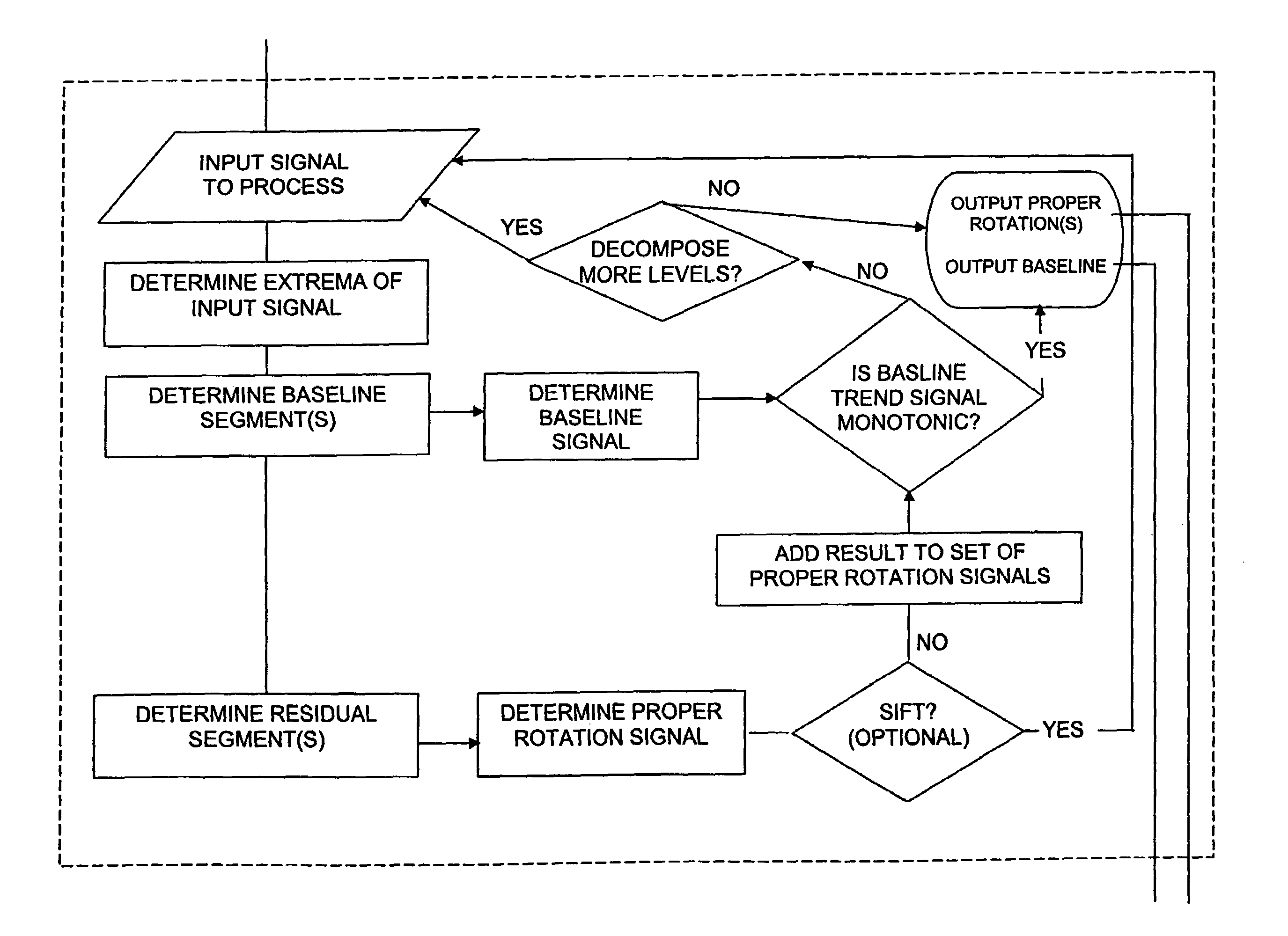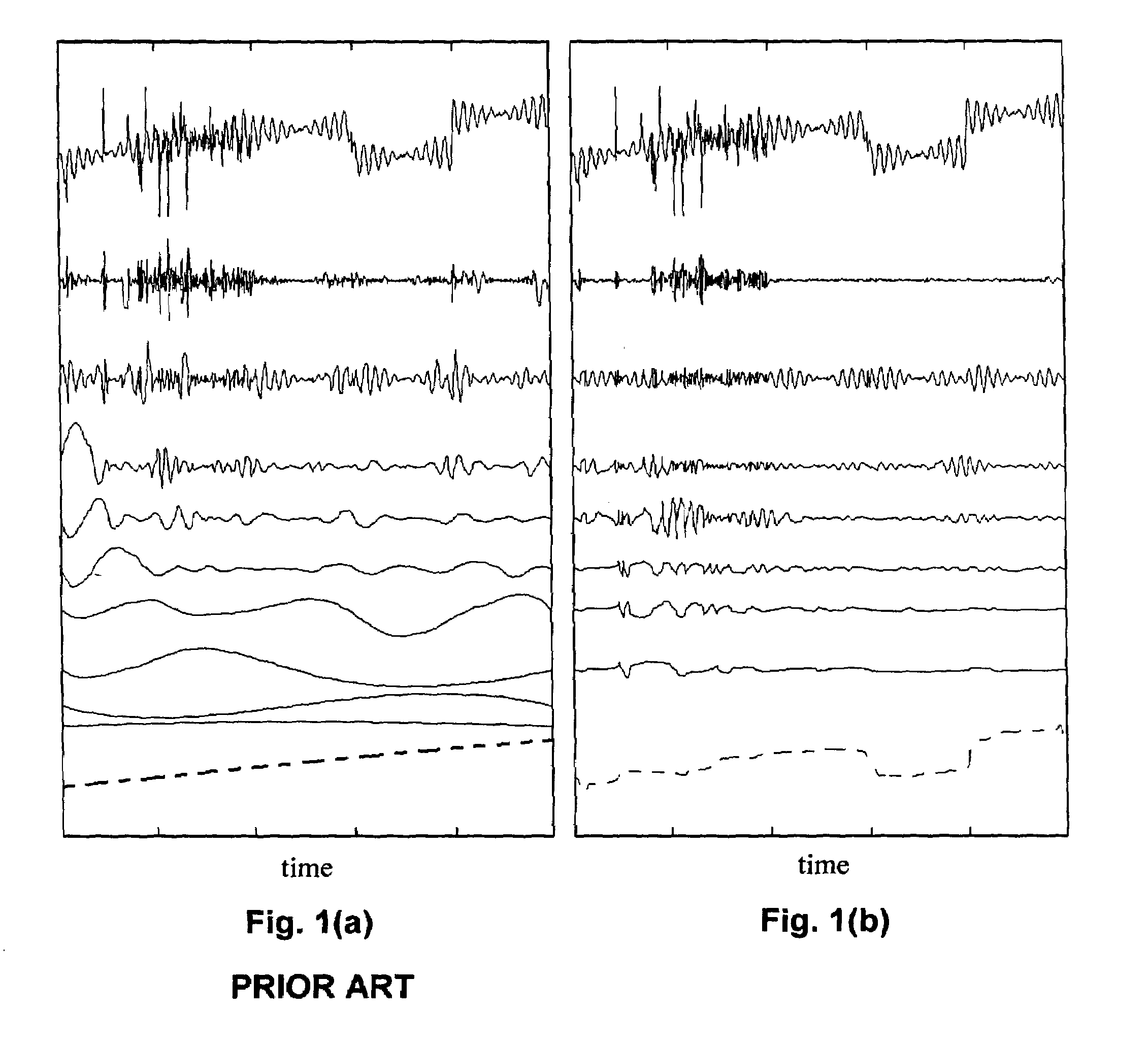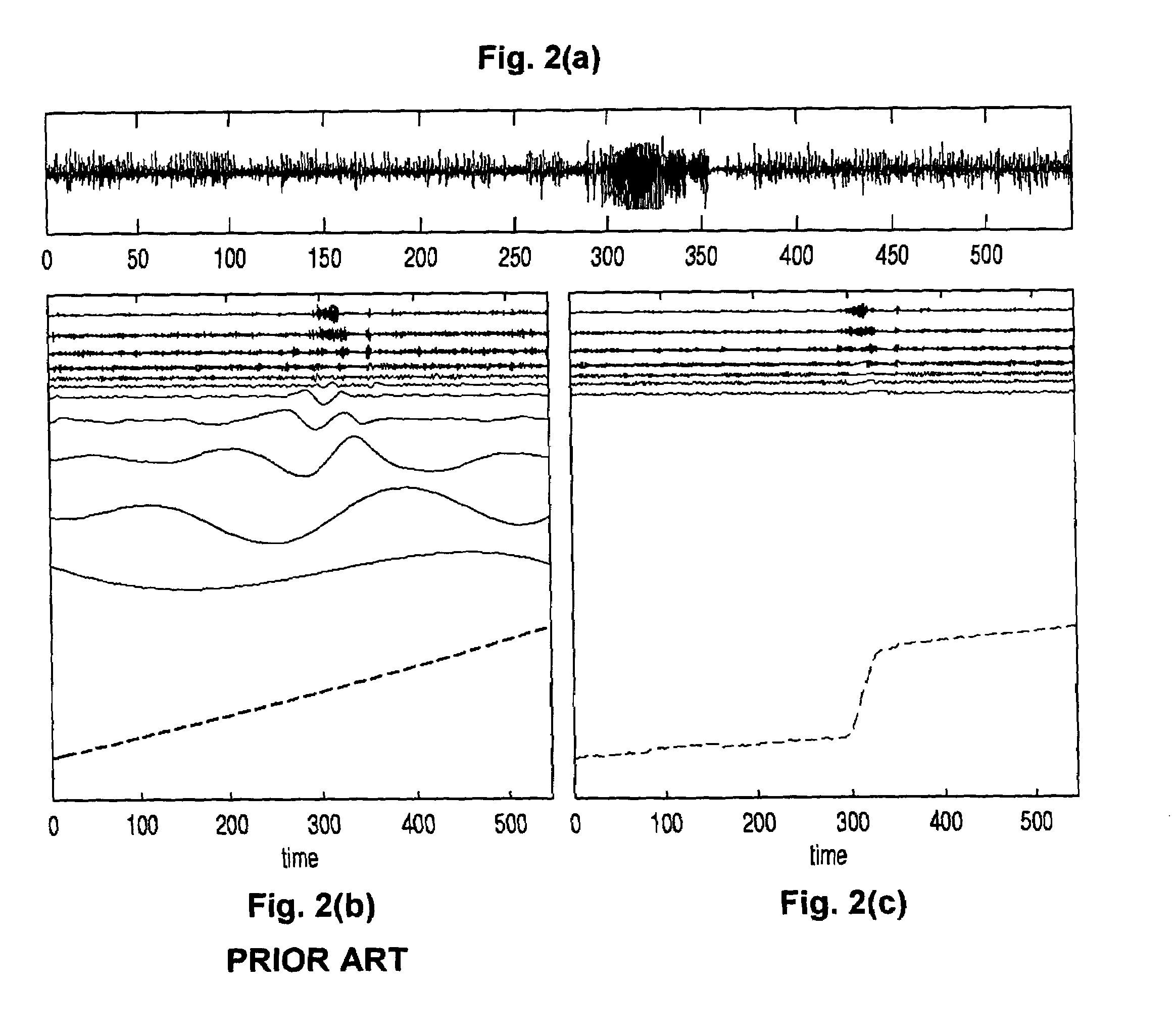In many practical applications, the
raw data have characteristics that change over time, commonly referred to as being non-stationary and, additionally, very often result from non-linear processes.
Unfortunately, the majority of existing methods for analyzing data are designed to treat stationary, linear data.
Another common and serious problem of
data analysis is the existence of
noise and / or non-stationary trend.
However, these filters are Fourier based and, as such, typically result in the introduction of spurious
harmonics in non-stationary data.
Therefore, Fourier-based filters have limited utility and practical value for use with non-stationary and / or non-linear data.
The application of these methods to analysis of non-stationary, non-linear data can give misleading results.
Therefore,
Fourier analysis needs many additional
harmonic components in order to simulate non-stationary data, which are not uniform globally.
Unfortunately, many of the components, that are added in order to simulate the non-stationary nature of the data in the
time domain, divert energy to a much wider
frequency domain.
As explained above, both non-stationarity and non-
linearity can induce spurious
harmonic components that cause energy spreading.
The resulting consequence is a misleading or incorrect time-frequency distribution of signal energy for non-linear and / or non-stationary data.
This assumption is not valid for most non-stationary data.
Furthermore, there are practical difficulties in applying the method.
Although the conflict in these requirements can be mitigated by different techniques, it renders the applicability of
Fourier analysis to non-linear, non-stationary data of limited use.
Unfortunately, the finite length of the basic
wavelet function results in
energy leakage across different levels of resolution in a multi-resolution analysis, which causes quantitative applications of the time-frequency-
energy distribution to be more difficult.
In many applications, the interpretation of such a result would be difficult if not impossible.
Another difficulty with
wavelet analysis is that it is not adaptive.
Unfortunately, these developments in wavelet analysis continue to suffer from the representation of the signal information in terms of a pre-selected basis of functions that often has little or nothing to do with the dynamics and other characteristics of the input signals.
The difficulty with this method is the severe cross terms indicated by the existence of
negative power for some frequency ranges.
Although this approach can be applied to a wide variety of problems, applications to nonstationary or nonlinear data are extremely complicated.
Further, such applications again suffer from the same limitation of the other prior art methods described above in that the bases for representation of information are not derived from the data itself.
The problem with this approach, which severely limits its applicability, is due to the lack of means for adequately defining the basis.
To date, no systematic method of constructing such a basis exists.
Therefore, it is impossible to construct an evolutionary spectrum from a given set of data.
Consequently, evolutionary
spectrum analysis has very little useful application, if any.
In addition, any
single component of the non-unique
decomposition, even if the basis is orthogonal, does not usually provide any physical meaning.
Unfortunately, since EOF components from a non-linear and non-stationary
data set are not linear and stationary, use of Fourier
spectral analysis generated by SSA is flawed.
Consequently, SSA is not a genuine improvement of EOF.
Although adaptive in nature, the EOF and SSA methods have limited applicability.
This does not necessarily happen with one step of EMD, and thus a laborious, iterative “sifting” process is applied to the signal baseline and is terminated when a set of “stopping criteria” are satisfied, such as when the resulting IMF either becomes a proper rotation or when some other criteria are reached (e.g., a predetermined number of iterations exhausted) without obtaining a proper rotation.
Unfortunately, these goals are often conflicting for non-stationary signals wherein riding
waves may be isolated and / or are highly variable in amplitude.
As a result, the sifting process must be applied cautiously as it can potentially obliterate the physically meaningful amplitude fluctuations of the original signal.
However, the EMD method suffers from a number of shortcomings that lead to inaccuracies in depiction of signal dynamics and misleading results in subsequent signal analysis, as follows:(a) The construction of the IMF baseline as the mean of the cubic spline envelopes of the signal suffers from several limitations, including the time scale being defined only by the local extrema of the original signal, ignoring the locations of the rest of the critical points, such as inflection points and zero crossings, which are not preserved by the sifting process.(b) The EMD transformation is window-based; the sifting procedure and other
processing requires an entire window of data to be repeatedly processed.
On average, this causes a
delay in obtaining the resulting information of at least half the window length plus the average computational time for a window of data.
As a result, an insurmountable problem is created for the EMD in real-time / online applications.
However, short windows have less accurate results due to boundary or
edge effects, and are incapable of resolving frequency information on a time scale longer than the window length itself.(c) The EMD method is computationally expensive, and also subject to uncertain computational expenses.
Therefore, the envelope-mean method of the extraction of the baseline does not work well in certain cases, such as when there are gaps in the data or data are unevenly sampled, for example.
Although this problem can be mitigated by using more sophisticated spline methods, such as the taut spline, such improvements are marginal.
Moreover, splines are not necessarily well suited to approximate long timescale trends in real data.(e) The EMD method does not accurately preserve precise
temporal information in the input signal.
Also, the EMD method, being exclusively determined by extrema, is deficient in its ability to extract weak signals embedded in stronger signals.(f) Since the cubic splines can have wide swings at the ends, the envelope-mean method of the EMD method is particularly unsuitable for real-time applications or for applications utilizing a narrow window.
Moreover, proper rotations, which are not guaranteed by the EMD, are necessary for the existence of a meaningful, instantaneous frequency that is restrictive and local.(h) Primarily due to the sifting procedure, the EMD method causes (i) a smearing of signal
energy information across different
decomposition levels, and (ii) an intra-level
smoothing of energy and frequency information that may not reflect the characteristics of the signal being decomposed or analyzed.
The potential negative effects of over-sifting include the obliteration of physically meaningful amplitude fluctuations in the original signal.
Also, the inter-level smearing of energy and limitation of decomposition in a window of data create inaccuracies in the EMD's representation of the underlying signal trend, especially if the signal trend is longer than a single window.(i) The EMD method cannot guarantee that the IMF components will be “proper rotations,” even with the sifting reiterations.
Often, in practice, they are not.(j) The EMD method is not well behaved if the data is unevenly sampled or if it is discontinuous, and, therefore, may not preserve intact phase and morphology characteristics of the signal.
 Login to View More
Login to View More  Login to View More
Login to View More 


